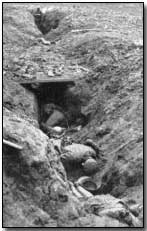Battles - The Battle of Delville Wood, 1916
 A subsidiary attack of the
Somme Offensive, and
fought from July 15 until 3 September 1916, the Battle of Delville Wood saw
the capture of the wood that had been skirted during the
Battle of Bazentin
Ridge when Longueval fell to the British on 9 July.
A subsidiary attack of the
Somme Offensive, and
fought from July 15 until 3 September 1916, the Battle of Delville Wood saw
the capture of the wood that had been skirted during the
Battle of Bazentin
Ridge when Longueval fell to the British on 9 July.
It was essential to the British that the wood be cleared of Germans before any attack could be launched on the formidable, and notorious, German Switch Line. The task of capturing the wood was handed to the South African Brigade of some 3,150 men, attached to the 9th Scottish Division.
On July 15 at dawn the South African regiment went in following a heavy artillery battle: they managed to clear the southern edge of German forces. The remainder of the wood remained in German hands.
Hand to hand fighting ensued until the South Africans were relieved on the night of July 19, having lost 766 dead among the four battalions alone; the dead outnumbered the wounded by four to one. Throughout poor weather (it rained often) and enemy artillery fire which reached a crescendo of 400 shells a minute, the surrounding landscape was transformed into a mess of broken, stumpy tree roots and massive shell holes.
Mud and rainwater covered bodies of South African and German forces alike - many bodies remain in the wood today (which is now in private hands). The Germans lost 9,500 men by August alone.
The wood was never entirely taken by the South African forces, despite huge efforts to do so. It wasn't until after another month of fierce fighting had taken place, on August 25, that 14th (Light) Division finally took the wood and overcame German resistance.
Delville Wood remained the most costly action the South African Brigade fought on the Western Front.
During the final great German push of March 1918 the wood was again taken by the Germans on March 24 but was recaptured by 38th (Welsh) Division on August 28.
Today the wood and nearby memorial is looked after by the South African Government. The Delville Wood Cemetery contains 5,493 burials. Almost two-third of these are unknown.
Photograph courtesy of Photos of the Great War website
A 'whizzbang' was a high-velocity, low-trajectory shell that made a shrill approach noise and then a sharp explosive report.
- Did you know?
